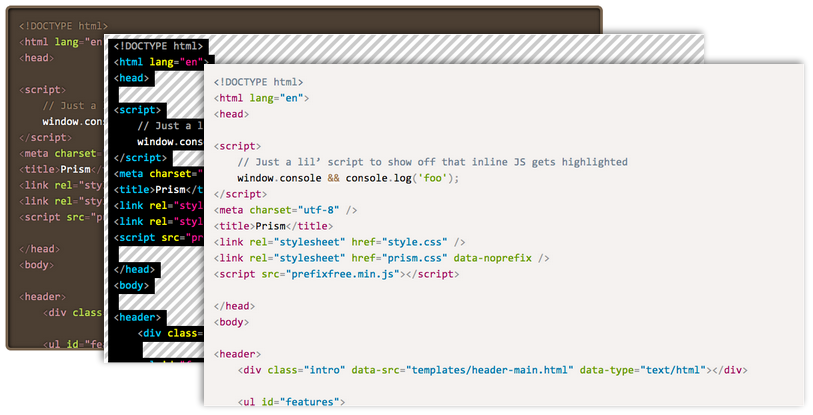I’ve been lucky enough to be invited to do about 25 talks over the course of the past few years and I have quite a few upcoming gigs as well, most of them at international conferences around Europe and the US. Despite my speaking experience, I’m still very reluctant to call myself a “professional speaker” or even a “speaker” at all. In case you follow me on twitter, you might have noticed that my bio says “Often pretends to be a speaker”, and that captures exactly how I feel. I’m not one of those confident performers that don’t just present interesting stuff, but also can blurt jokes one after the other, almost like stand-up comedians and never backtrack or go “ummm”. I greatly admire these people and I aspire to become as confident as them on stage one day. People like Aral Balkan, Christian Heilmann, Nicole Sullivan, Jake Archibald and many others. Unlike them, I often backtrack mid-sentence, say a lot of "ummmm"s and sometimes talk about stuff that was going to be later in my slides, all of which are very awkward.
However, I’ve reached the conclusion that I must be doing something right. I do get a lot of overwhelmingly positive feedback after almost every talk, even by people I admire in the industry. I don’t think I’ve ever gotten a negative comment for a talk, even in cases that I thought I had screwed up. Naturally, after all these conferences, I’ve attended a lot of technical talks myself, and I’ve gathered some insight on what constitutes a technical talk the audience will enjoy. I’ve been pondering to write a post with advice about this for a long time, but my lack of confidence about my speaking abilities put me off the task. However, since people seem to consider me good, I figured it might help others doing technical talks as well.
All of the following are rules of thumb. You have to keep in mind that there are exceptions to every single one, but it’s often quicker and more interesting to talk in absolutes. I will try to stay away from what’s already been said in other similar articles, such as “tell a story” or “be funny” etc, not because it’s bad advice, but because a) I’m not really good at those so I prefer to let others discuss them and b) I don’t like repeating stuff that’s already been said numerous times before. I will try to focus on what I do differently, and why I think it works. It might not fit your style and that’s ok. Audiences like a wide range of presentation styles, otherwise I’d be screwed, as I don’t fit the traditional “good speaker” profile. Also, it goes without saying that some of my advice might be flat out wrong. I’m just trying to do pattern recognition to figure out why people like my talks. That’s bound to be error-prone. My talks might be succeeding in spite of X and not because of it.
There are many nice talks with good minimal slides (almost everyone has read Presentation Zen by now), funny pictures, good content and confident presenters. In fact, they dominate almost every conference I’ve been at. You can always become a good speaker by playing it safe, and many famous speakers in the industry have earned their fame by doing so. There is absolutely nothing wrong with that. However, to stand out doing that kind of talk, you need to be really, really good. Hats off to the speakers that managed to stand out doing talks like that, because it means they are truly amazing.
However, if you, like me, fear that your speaking skills are not yet close to that caliber, you need to figure out something else that sets you apart. Something that will make your talk memorable. We see a lot of innovation in our discipline, but it’s limited to the scripts and apps we write. Why not to our presentations as well? Do something different, and make it your thing, your “trademark” way of presenting.
For me, that was the embedded demos in my slides. I usually have a small text field where I write code, and something (often the entire slide or text field itself) that displays the outcome. This lets the attendees see not just the end result, but also the intermediate states until we get there, which often proves out to be enlightening. It also makes the slide quite flexible, as I can always show something extra if I have the time.
Of course, it also means that things might (and if you talk often enough, will at some point) go wrong. To mitigate this to a degree, I try to keep demos small, with a sensible starting state, so that I won’t have to write a lot of code. Which brings us to the next point.
I have a theory: Attendees’ understanding of code decreases exponentially as the lines of simultaneously displayed code increase. Avoid showing many lines of code at once like the plague. Although I’ve shown up to 10 lines of code on a single slide (maybe even more), I usually try to keep it well below five. Ideally less than three even. If you absolutely must present more code, try to use a technique to make the audience understand it by chunks, so that they still only have to process very little code at any given time.
One technique I use for that is showing little code at first, and writing the rest on stage, gradually, explaining the steps as I go. When that isn’t possible or it doesn’t make sense (for example when there is no visual result to see), I try to show parts of the code step by step, explaining what everything does as it appears. This doesn’t necessarily mean showing one line at a time. For example, if you are showing a JS function, it makes sense to show the closing brace at the same time as the opening brace and not at the end. Show the elements of the code in the order you would write them in a top-down implementation, not by pure source order (although in some cases those two may coincide). To make this more clear, here’s an example slide where I used this technique. It’s from my “Polyfilling the gaps” talk at JSConf EU 2011, one of the very few talks of mine that had no live coding.
Also, it goes without saying that if you have to present a lot of code at once, syntax highlighting is a must. Comments aren’t: That’s what you are there for. Comments just add visual clutter and make it harder for people to interpret the actual code. Also, while explaining the code, try to somehow highlight the part you’re currently describing, even if your method is as rudimentary as selecting the text. Otherwise, if someone misses a sentence, they will completely lose track.
I’ve seen this so many times: Someone wants to live demo a technology and fires up their IDE or text editor and starts coding. The audience tries to follow along at first, but at some point almost always gets lost. While these tools are great for programming, they are not presentation tools. They have a lot of distracting clutter, very small text and require you to show parts of the code that aren’t really relevant. They also require you to switch applications to toggle between the code and result, which disrupts the flow of your presentation.
In addition, the probability you will make a mistake increases exponentially with the amount of code you write, both in real life and especially in presentations where you are also nervous. Then the audience is stuck with an embarrassed presenter trying to find what’s wrong for five minutes, until someone from the audience decides to put them out of their misery and shout that a closing parenthesis is missing on line 25.
That’s why live coding has gotten a bad reputation over the years.
As you’ve probably figured from tip #1, I’m not against live coding. Done well, it can really help the audience learn. However, if not done properly, it can end up completely wrecking a talk. Even if you absolutely have to use an external tool, try to make the experience as smooth as possible:
- Hide any toolbars, sidebars, panels. If your editor doesn’t allow you to hide everything that isn’t relevant, use another editor.
- Make the text BIG. If possible, as big as the text in your slides. Remember: Text in slides is big, because you need even the attendees sitting in the back rows to still be able to read it. Why is it that this simple consideration seems to escape so many presenter minds when they switch from slides to code?
- If parts of the code are needed but not relevant (e.g. CSS files in a JavaScript talk), put them in separate files and reference them. Try to minimize the code you will actually show as much as possible, and then even more.
- If applicable, use LiveReload and have the browser window and code editor side by side.
Some of the nastiest criticism I’ve seen against people’s talks was that they were too elementary. Getting feedback like that has almost become a phobia of mine. Of course, it’s always better if your entire audience is at the same level, and you are fully aware what that level is. However, that’s almost never the case, so you will have to err on one side. Do your best to cater to the median, but when you have to err, err on the side of more advanced content. A somewhat selfish reason would be that when people find your talk too elementary, they will blame you; when they find it too advanced, they will blame themselves. However, it’s not just covering your ass, it’s better for your audience as well. Someone who didn’t learn anything new gets absolutely nothing out of your talk (unless it’s an interesting performance on its own, e.g. so funny it could have been stand up comedy for geeks). A person that learned many things but didn’t understand some of the more advanced concepts will still have gotten a lot out of it.
If someone learns a useful thing or two from your talk, that’s what they’ll remember. Even if the rest of the talk was elementary or too advanced for them, they will walk out with a positive impression, thinking “I learned something today!”. Even if most of your talk is elementary, try to sneak in some more advanced or obscure bits, that not many people know.
My favorite approach to cater for a diverse audience with very different levels of experience, is to pick a narrow topic, start from the very basics and work my way up to more advanced concepts. This way everyone learns something, and nobody feels intimidated. On the flip side, if you are in a multi-track conference, this also limits the potential audience that might come to your talk.
I’m a huge fan of HTML-based (or SVG-based) slideshows. I’ve always been, since my first talk. It’s a technology you’re already accustomed to, so you can do amazing things with it. You can write scripts that demonstrate the concepts you describe in some visual way, you can do live demos, you can embed iframes of other people’s demos, you know how to style it much better than you likely know how to use Keynote. Yes, if you’re used to traditional presentation tools, it might be hard at first. Many features you’ve been taking for granted will be missing. Styling is not visual, there are no presenter notes, no next slide preview, no automatic adjustment to the projector resolution to name a few. But what you gain in potential and expressiveness, are totally worth the trade-off. Also, rather than having the talk prep keep you from writing code and becoming better at what you do, it will now actually contribute to it! It’s also a great chance to try experimental stuff, as it’s going to be run in a very controlled environment.
You don’t even need to write your own presentation framework if you don’t want to. There are a ton available now, such as my own CSSS, impress.js and many others.
There is an old Chinese proverb that goes like:
Tell me, and I’ll forget Show me, and I’ll remember Involve me, and I’ll understand
I’ve noticed that audiences respond extremely well to talks that attempt to involve them. Seb-Lee Delisle gave a talk at Fronteers 2011 where he involved the audience by ideas like demonstrating Web Sockets through making their iPhones flash in such a way that he could create light patterns with the audience. Even though some of the demos failed (I think something crashed, don’t remember very well), the audience loved every bit. I’ve rarely seen people that excited about a talk.
Involving the audience was something I wanted to do for a while. In my recent Regular Expressions talks, I had a series of small “challenges” where the audience tried to write a regexp to match a certain set of strings as quickly as possible and tweet it. I provided a link to an app I made especially for that. The person who got most regexes right (or more right than others) won a book. This was also very well received and lots of positive feedback mentioned it. When it feels like a game, learning is much more fun.









